Mucosal immunization with a Staphylococcus aureus IsdA-cholera toxin A2/B chimera induces antigen-specific Th2-type responses in mice
- PMID: 21734065
- PMCID: PMC3165230
- DOI: 10.1128/CVI.05146-11
Mucosal immunization with a Staphylococcus aureus IsdA-cholera toxin A2/B chimera induces antigen-specific Th2-type responses in mice
Abstract
Staphylococcus aureus is a leading cause of opportunistic infection worldwide and a significant public health threat. The iron-regulated surface determinant A (IsdA) adhesin is essential for S. aureus colonization on human nasal epithelial cells and plays an important role in iron acquisition and resistance to human skin defenses. Here we investigated the murine immune response to intranasal administration of a cholera toxin A(2)/B (CTA(2)/B) chimera containing IsdA. Plasmids were constructed to express the IsdA-CTA(2)/B chimera and control proteins in Escherichia coli. Proper construction of the chimera was verified by SDS-PAGE, Western blotting, GM1 enzyme-linked immunosorbent assay (ELISA), and confocal microscopy. Groups of female BALB/c mice were mock immunized or immunized with IsdA-CTA(2)/B, IsdA mixed with CTA(2)/B, or IsdA alone, followed by one booster immunization at 10 days postpriming. Analysis of serum IgG and nasal, intestinal, and vaginal IgA suggested that mucosal immunization with IsdA-CTA(2)/B induces significant IsdA-specific humoral immunity. Functional in vitro assays revealed that immune serum significantly blocks the adherence of S. aureus to human epithelial cells. Splenocytes from mice immunized with IsdA-CTA(2)/B showed specific cellular proliferation and production of interleukin-4 (IL-4) after in vitro stimulation. Immunization with IsdA-CTA(2)/B drove isotype switching to IgG1, indicative of a Th2-type response. Our results suggest that the immunogenicity of the S. aureus IsdA-CTA(2)/B chimera merits further investigation as a potential mucosal vaccine candidate.
Figures
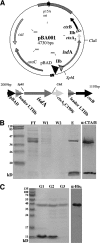
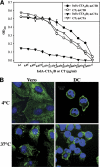


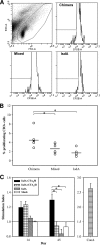
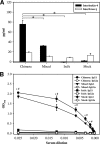
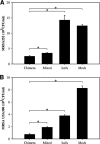
References
-
- Agren L. C., Ekman L., Lowenadler B., Lycke N. Y. 1997. Genetically engineered nontoxic vaccine adjuvant that combines B cell targeting with immunomodulation by cholera toxin A1 subunit. J. Immunol. 158:3936–3946 - PubMed
-
- Ayalew S., Step D. L., Montelongo M., Confer A. W. 2009. Intranasal vaccination of calves with Mannheimia haemolytica chimeric protein containing the major surface epitope of outer membrane lipoprotein PlpE, the neutralizing epitope of leukotoxin, and cholera toxin subunit B. Vet. Immunol. Immunopathol. 132:295–302 - PubMed
Publication types
MeSH terms
Substances
Grants and funding
LinkOut - more resources
Full Text Sources
Other Literature Sources
Miscellaneous

